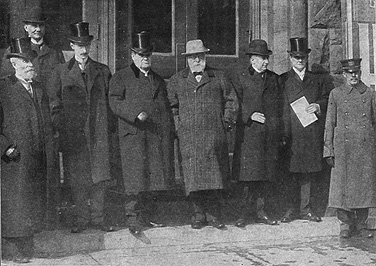Flashback
110 years ago
University Day

Chancellor Charles P. Norton, second from right, and Buffalo mayor J.N. Adam, fourth from right, at the 1909 University Day. Photo: UB ARCHIVES
When the UB community assembled for the last midyear commencement in 1969, it marked the end of a February tradition dating to 1901.
The idea for an annual event to bring faculty, current and former students, and community leaders together to “promote a higher university spirit” originated with a committee consisting of representatives from UB’s four schools: Medicine, Pharmacy, Law and Dentistry. Scheduled for Washington’s birthday, University Day began as an annual occasion for “patriotic exercises.”
The first University Day, on Feb. 22, 1901, was held in the Star Theater, located where Pearl, Mohawk and Genesee streets once intersected in downtown Buffalo. Students and faculty entered the theater behind a band. Much cheering and singing followed. University of Rochester President Rush Rhees was the first in a list of distinguished speakers invited over the years to University Day exercises.
In the early years of the 20th century, UB sought support from the community for its plan to become a “greater university”—more than just four professional schools. UB’s leaders sought to have political and business leaders participate in the annual exercises with the hope that developing a great university would be seen as a point of civic pride for Buffalo.
On several occasions, other events were celebrated in conjunction with University Day. The 75th anniversary of the university’s founding and the successful completion of the 1920 endowment fund campaign were celebrated as part of University Day in 1921. The dedication of Hayes Hall was celebrated as part of the exercises in 1928.
Beginning in 1925, the Chancellor’s Medal was presented as part of University Day exercises. When the late Chancellor Charles P. Norton left funds to establish the Chancellor’s Medal, he specified that the award be presented to “some citizen who performed some great thing which is identified with Buffalo” and thereby dignifying “the performer and Buffalo in the eyes of the world.” In the spirit of civic pride in Buffalo and its university, Norton also specified that the medal be presented on Washington’s birthday as part of University Day exercises. It also was in 1925 that a midyear commencement ceremony became part of University Day.
In the years immediately preceding the 1915 University Day, UB’s efforts to secure community support for establishing a liberal arts program were floundering. So, it was welcome news when the “University Bison” reported that “the project of the greater University of Buffalo received several evidences of complete revitalization on February 22nd, during University Day exercises at the Teck Theater.”
Five new scholarships were announced and Mrs. Adelbert Moot spoke on behalf of the Women’s Educational and Industrial Union.
The Buffalo branch of the union, founded in 1884 by Harriet A. Townsend, was dedicated to promoting” the material, moral and intellectual welfare of women.” The union was disbanding, and the Women’s Educational and Industrial Union building at Niagara Square was being presented to UB for a new college of liberal arts.
“The union has always stood for civic betterment” and “has concentrated its efforts for obtaining justice and protection for women,” said Mrs. Moot. “In your hands this institution is again to undertake a pioneer work for a wider and deeper culture. Dear to us is the past of the Woman’s Union, with all it cherished memories and achievements, and equally dear to us shall be the future of the college of liberal arts. With this gift go all our confidence and prayers that genuine, moulding, humanizing culture will rise above the horizon and dignify the human life of our city.”
UB renamed the building Townsend Hall, and in accepting the building, Norton pledged that the university would “maintain it in the high purpose and endeavor with which the Women’s Educational and Industrial Union was founded. That purpose was for educational and social advancement. Townsend Hall stands as a monument of the work of women for women, and the university receives it and dedicates it anew to the larger work of moulding to high ends and developing to more complete manhood and womanhood the youth of the city for all time to come.”
The building was presented to UB with the condition that the university raise $100,000 toward a future endowment. On Feb. 22, 1916—University Day—Grace M. Knox donated $250,000 in memory of her late husband, Seymour H. Knox Sr. The future of UB’s liberal arts program—the College of Arts and Sciences—was secure.
There also was the stipulation that “if said premises be sold by the University of Buffalo, this name shall be perpetuated by the university.” In 1922, the College of Arts and Sciences moved to the newly completed Foster Hall. The Evening Session, known today as Millard Fillmore College, used the building before it was sold in 1954. The Townsend Hall name was transferred to what was then known as the Biology Building on the South Campus.
University Day continued to be an occasion when gifts to the university were announced. Eventually, the event became known as Midyear Convocation, and by 1950, as Midyear Commencement. Since 1970, the Chancellor’s Medal has been presented at the annual general commencement.
—John Edens, University Archives

Reader Comments
Shonnie Finnegan says:
The Flashback articles prepared by University Archives staff are so well researched, written, and illustrated. I'm amazed that with all his other responsibilities John Edens and occasionally other staff manage to put these out every week.
I hope they'll continue and remain accessible for a good long time!
Posted by Shonnie Finnegan, University Archivist Emerita, 02/10/11